|
Report from
Europe
Tropical wood continues to lose share in European
flooring market
European consumption of real wood flooring (i.e.
excluding laminates) remains flat and the role of tropical
timber in this sector is declining. This is apparent from
combined analysis of Eurostat trade data and the latest
market report by the FEP (European Federation of the
Parquet Industry) released on 16 June 2017 at the
Federation*s annual general meeting in Budapest,
Hungary.
Prior to the global financial crises, nearly 20 million sq.m
of the 100 million sq.m of real wood flooring
manufactured in Europe was faced with tropical
hardwood. Another 20 million sq.m was imported directly
from the tropics.
However, in the last decade a host of factors have
conspired to drastically reduce the role of tropical wood in
this sector, including the shift to engineered flooring
products, intense competition from Eastern European and
Chinese manufacturers for market share, a progressive
switch to oak at the expense of all other hardwoods, a glut
in supply of cheaper laminates and non-wood alternatives,
the development of new and improved look-alike surfaces,
and an increasing focus on legality due diligence and
certification.
Drawing on information from member companies and
affiliated national associations, FEP provides detailed data
on real wood consumption and production in 16 European
countries covered by the FEP.
This data shows that consumption increased 1.7% in 2016
to 77 million sq.m in the 16 FEP countries, building on a
0.5% gain in 2016. It also shows that production in these
countries increased 2.5% to 65.6 million sq.m, with
notable gains in Poland, Sweden, Austria, Germany,
France and Spain (Chart 1).
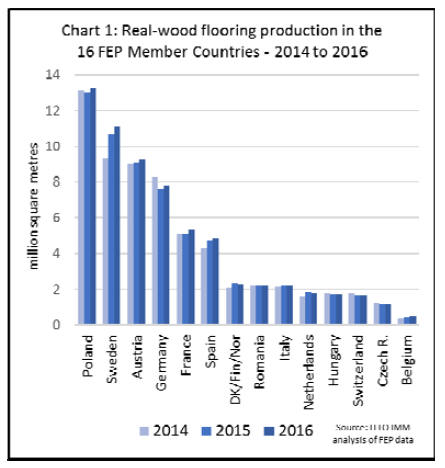
According to FEP, in 2016 multilayer parquet floors
accounted for 80% of wood floors manufactured in the 16
FEP countries, up from 79% in 2015 (the majority
comprising three-layer parquet). Solid wood flooring
accounted for 18% of production, down from 19% in
2015, while mosaic accounted for 2%.
Data in the FEP annual report also indicates that total realwood
flooring production in the EU28 as a whole
increased 2.4% from 76.9 million sq.m in 2015 to 78.7
million sq.m in 2016.
Combining this with Eurostat trade data, which shows a
3.9% decline in imports and a 5.5% rise in exports by the
EU in 2016, consumption within the trading block appears
to have declined slightly, by 0.5%, during the year (Chart
2).
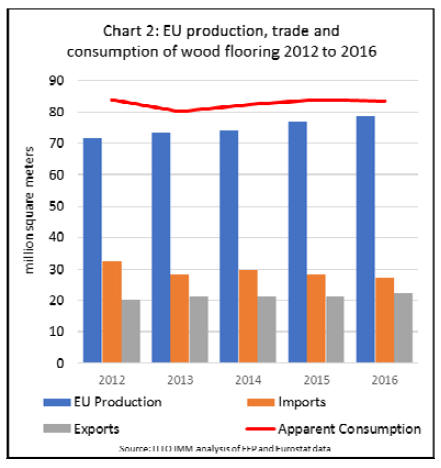
The combination of FEP and Eurostat data shows that the
share of all real-wood flooring supplied into the EU single
market by domestic manufacturers was 74.4% in 2016, up
from 73.2% in 2015 and from 68.6% in 2012.
This analysis confirms that external suppliers into the EU
continue to lose share in the wood flooring sector. Eurostat
data also reveals that, amongst external suppliers to the
EU, tropical countries are rapidly losing share to temperate
countries.
EU28 imports of real wood flooring from the tropics
declined 18% to 3.46 million sq.m in 2016. Imports from
China also fell in 2016, by 8% to 15.9 million sq.m.
In contrast, imports from Ukraine increased 28% to 3.99
million sq.m, 21% from Switzerland to 1.28 million sq.m
and 25% to 1.2 million sq.m from Bosnia. The continuous
shift away from tropical suppliers of real-wood flooring is
made apparent in Chart 3.
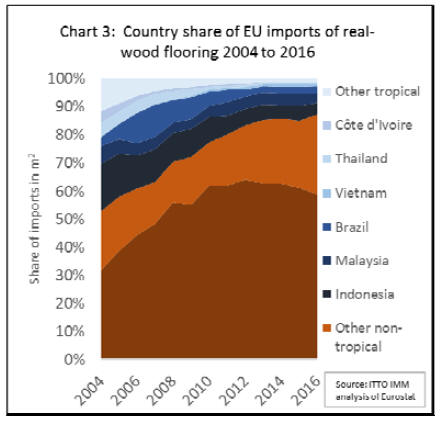
FEP data highlights the increasing reliance on oak in the
EU wood flooring sector, a factor which is both a result of,
and serves to reinforce, the dominance of domestic
suppliers in the EU market. The share of oak surfaces in
European real-wood flooring production increased from
77.7% in 2015 to 80.8% in 2016.
Meanwhile the share of tropical timber fell from 4.5% to
only 4.1%. Beech also fell from 3.8% to 2.5% and maple
from 1% to 0.6%. In fact, the only timber other than oak to
increase share was ash, rising from 5.6% in 2015 to 5.7%
in 2016, mainly because it is regarded as a cheap oak
substitute. (Chart 4).
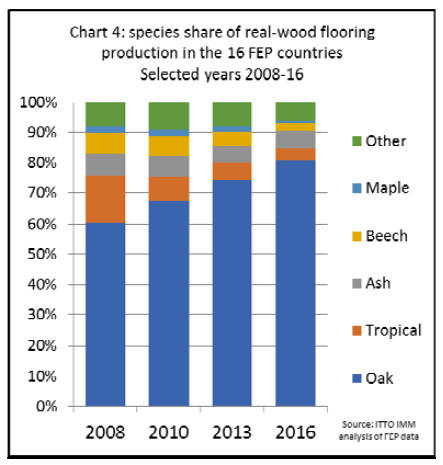
The dominance of oak in flooring and the wider market for
interior furnishings is now acknowledged to be a serious
problem for the European hardwood sector. FEP observed
in their annual report that ※the growing shortage of oak as
primary raw material source remains a major concern and
has to be stressed once again§.
Similarly, the American Hardwood Export Council
(AHEC) in their report of the Interzum show in Cologne,
Germany, during May noted that ※for some importers, oak
(mostly from European sources) has increased from 50-
60% of their hardwood business to 80% or more in recent
years. Most of the hardwood traders AHEC spoke to
expressed concern about the unhealthy nature of the
situation and would like to see more demand for other
species§.
Laminates share of European flooring sector on the
rise
Another issue touched on in the FEP report is the
challenge for real wood flooring from laminates and nonwood
substitutes. The sheer scale of this challenge was
made clear from data published in May 2017 for the
Annual General Meeting (AGM) of the Federation for
European Producers of Laminate Flooring (EPLF).
Laminate flooring composed of HDF with a high
resolution printed image and embossed to provide texture
has been substituting for hardwood flooring now for well
over a decade.
However, the surface finishes continue to improve and
have become so convincing that, as the FEP comments; ※it
is becoming increasingly difficult for consumers to
differentiate parquet from competitive flooring alternatives
with a wood look surface.§
In contrast to the generally static market for real wood
flooring, EPLF members reported a 5.5% increase in sales
in 2017. Sales by European laminate manufacturers, at 477
million sq.m last year, now dwarf those of the real wood
flooring sector.
While EPLF members sales in Western Europe increased
by only 0.5% in 2016, to 223 million m2, they increased
14% to 126 million m2 in Eastern Europe, with strong
growth in Poland (+11%), Russia (+17%), Ukraine
(+20%) and Romania (+27%). (Chart 5).
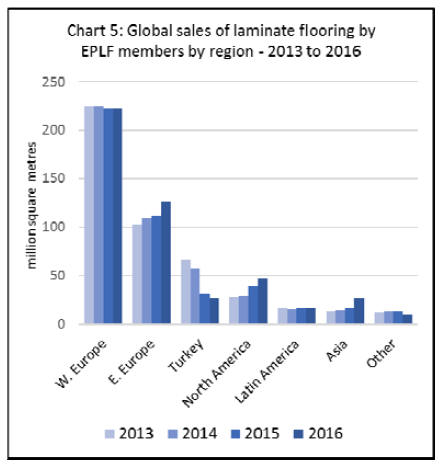
European panels sector creates challenges for tropical
wood.
Of the wide range of panel products used in Europe, only
plywood is sourced in any volume from outside the region.
For this reason, the wood panels sector in Europe is
mainly of interest to tropical countries for the important
role it has played to drive development of tropical wood
substitutes.
In addition to the competition to hardwood flooring from
HDF-based laminate flooring referred to in the previous
section, OSB is an important competitor for construction
plywood while MDF has taken a rising share of the EU
interior decorative mouldings market, often replacing
lighter tropical hardwoods such as wawa/ayous.
The EU panels sector also remains a key source of
innovation in the international forest products sector and
continues to extend applications into new areas, often at
the expense of tropical wood products.
For example, a new process launched in 2011 to acetylate
MDF has created a product that can be used for exterior
applications, with a 50-year guarantee above ground and
25 years in ground, which now competes directly with
tropical hardwood products in exterior applications.
A less direct impact of the European panels sector on the
tropical wood trade, but perhaps just as important, is the
central role it plays to promote the wider sustainability
agenda in European market.
As a product based on wood fibre either from certified
forests in Europe or from off-cuts and other waste
material, Europe*s panel manufacturers have had a strong
incentive to promote the FSC and PEFC labels.
They have also been at the heart of European policy
initiatives to improve waste efficiency and promote the
circular economy and cascaded use of wood.
All these various themes were featured at the European
Panel Federation (EPF) AGM held in Porto, Portugal, on
29/30 June 2017. The EPF is one of the more influential
wood industry associations in Europe. The organisation
represents members in 25 countries including the
manufacturers of particleboard, MDF, OSB, hardboard,
softboard and plywood. The industry has an annual
turnover of about 22 billion Euros, employs over 100,000
people directly and includes more than 5,000 enterprises in
Europe.
In a review of the industry delivered to the event, the EPF
Managing Director reported that production in European
wood-based panels continued to recover slowly from the
downturn following the global financial crises.
Total production increased by 1.8% in 2016, to 55.6
million cu.m, still well below the level in excess of 70
million cu.m recorded in 2008 before the global financial
crises.
Production increased in 2016 across all the main product
categories including particleboard (+0.8% to 30.2 million
cu.m), MDF (+2.0% to 12 million cu.m), OSB (+6.9% to
5.4 million cu.m), softboard (+4% to 4.6 million cu.m),
and plywood (+2.5% to 2.9 million cu.m).
The only panel for which production did not increase in
2016 was hardboard which declined 5.6% to 0.5 million
cu.m.
At the AGM, members of the EPF endorsed priority areas
for future action to strengthen the market for European
panels and secure the future of the association:
E1 Compulsory 每 to seek EU legislation that endorses the
E1 standard for formaldehyde emissions as the minimum
requirement for panels placed on the EU market (E1
adhesives are required to have less than 0.75 formaldehyde
parts per million).
New Standard 每 to lead a project to define a single low
formaldehyde emission standard to arrest the proliferation
of different limit levels around the world and to facilitate
trade.
Image 每 to profile the wood-based panels industry as a
leader in Europe*s drive towards a circular economy and
resource efficiency, especially focusing on the Cascade
Use of Wood and its benefits.
Construction 每 to increase the use of wood-based panels in
construction, thereby growing the market whilst helping to
mitigate climate change due to wood*s carbon storage
qualities.
Africa 每 to share European experience of the production,
certification and marketing of wood-based panels with the
leaders of this growing market, thereby becoming a future
reference point.
Communications 每 to develop a new communications
model, including a new website, to bring EPF*s messages
and activities to members, internal and external
stakeholders, and to the general public.
Certification 每 to add the voice of EPF members to the call
for wood to come from certified and sustainable sources,
with no associated unnecessary bureaucracy and cost.
Biomass 每 existing industries to be safeguarded via a level
playing field, free from market distortions, allowing the
EU*s Circular Economy and Renewable Energy Directive
to work in harmony.
Federations 每 EPF to maintain and increase its profile
towards EU and national institutions working with
members, related wood-working industry federations and
NGOs.
Safe Finances 每 to achieve all of the above within a
balanced budget, ensuring the member contributions and
additional income cover expenses.
Acetylated wood strives to gain European market
foothold
The latest financial report of Accsys Technologies plc
suggests that acetylated wood, often cited as a competitor
to tropical wood in high exposure applications, is making
slow headway in the European market. The Dutch-based
modified wood producer recorded an 18% sales volume
increase in the year ended March 31, 2017, but also a loss
before tax of €4.4m (2016: €0.5m loss).
The 18% sales growth of Accoya acetylated wood saw
volumes increase to 39,790 m3 in the year, with a 31%
rise in the second half of the period. Sales by Medite of
Tricoya panels increased by 32% to 5,806 m3 last year.
Given the level of ambition for the accoya and tricoya
products, these volumes are still quite restricted. Accsys
claims that the potential market for Accoya and Tricoya
exceeds 2.6 million m3 annually 每 a very large figure
which implies the company has ambitions to capture a
large share of the existing European market for timber in
external applications and to expand into other regions.
Accsys observes that "Accoya captures the market share in
those applications which require rot, insect and water
resistance, i.e. primarily outdoor products. The Group is
focused on the higher-value end of these applications,
where the dual qualities of durability and dimensional
stability offered by Accoya are most highly valued.§
Target applications for Accoya include windows, doors,
decking and cladding and for Tricoya include facades and
cladding, soffits and eaves, exterior joinery, wet interiors,
door skins, flooring, signage and marine uses.
ATIBT planning one-stop tropical wood website
The ATIBT (International Tropical Timber Technical
Association) is building a one-stop website giving
performance and other use and specification data for
tropical timber species. This complements the ITTO LUS
species database launched in 2015.
See:
http://www.tropicaltimber.info/
The organisation, which has won support for the initiative
as a project of the Sustainable Tropical Timber Coalition
(STTC), says the goal is to make it easier for the trade to
sell tropical hardwood, and for end users and specifiers to
select the right material for the job. The aim is also to
broaden application of tropical wood by increasing market
confidence in using it in more areas and more ambitious
projects.
ATIBT has asked national European trade federations to
back the site, to support translation and provide
&catalogues* of popular species in their market. Most have
agreed.
The site is modelled on www.boistropicaux.org, which is
operated by French trade association Le Commerce du
Bois.
The ATIBT site will incorporate pictures of species and
applications, underpinned with technical specification data
from the Tropix database of French-based agricultural
research organisation CIRAD.
The new facility will also provide links to complementary
online sources, including the joint ETTF/ATIBT
www.timbertradeportal.com legality assurance and
business link website, which is sponsored by ITTO, and
the species specification guide at
www.houtdatabase.nl .
The new ATIBT site should be complete by the end of
July.
|